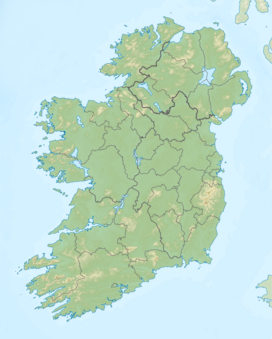Tibradden Mountain
| Tibradden Mountain (Sliabh Thigh Bródáin) |
|
|---|---|
| Garrycastle; Kilmainhambegg | |

Tibradden from Montpelier Hill
|
|
| Highest point | |
| Elevation | 467 m (1,532 ft) |
| Prominence | 30 m (98 ft) |
| Coordinates | 53°14′19″N 6°16′49″W / 53.238744°N 6.280158°WCoordinates: 53°14′19″N 6°16′49″W / 53.238744°N 6.280158°W |
| Geography | |
| Location | County Dublin, Ireland |
| Parent range | Dublin Mountains |
| OSI/OSNI grid | O1487822281 |
| Topo map | OSI Discovery No. 50 |
Tibradden Mountain (Irish: Sliabh Thigh Bródáin, meaning "mountain of the house of Bródáin") is a mountain in County Dublin in Ireland. Other names for the mountain include "Garrycastle" and "Kilmainham Begg" (a reference to Kilmainham Priory which once owned the lands around the mountain). It is 467 metres (1,532 feet) high and is the 561st highest mountain in Ireland. It forms part of the group of hills in the Dublin Mountains which comprises Two Rock, Three Rock, Kilmashogue and Tibradden Mountains. The views from the summit encompass Dublin to the north, Two Rock to the east and the Wicklow Mountains to the south and west. The geological composition is mainly granite and the southern slopes are strewn with granite boulders. The summit area is a habitat for heather, furze, gorse and bilberry as well as Sika deer, foxes and badgers. The forestry plantation on the slopes – known as the Pine Forest – contains Scots pine, Japanese larch, European larch, Sitka spruce, oak and beech. The mountain is also a site of archaeological interest with a prehistoric burial site close to the summit.
Close to the summit is a prehistoric burial site. Local tradition associates it, incorrectly, with Niall Glúndub. It was excavated in 1849 by members of the Royal Irish Academy who found a stone-lined cist containing a pottery vessel and cremated remains, now preserved by the National Museum of Ireland in Dublin. In its present form, the site consists of an open circular chamber 10 feet (3.0 metres) in diameter with a narrow passage. For many years, it was believed that this monument was a passage grave and the author Robert Graves refers to it as such in his poetic mythological work The White Goddess (1948). However, conservation work done at the site in 1956 revealed that the chamber and passage were not original features but had probably been created at the time of the original excavation in the nineteenth century. A stone bench was also found in the centre, apparently built for the convenience of visitors to the site. It is now accepted that the monument is in fact a chambered cairn with a cist burial at the centre. The site may be the burial place of Bródáin, after whom the mountain is named. The monument is not at the summit of the mountain but is located slightly to the north at a position where the view across Dublin Bay to Howth is not obscured by Two Rock. Within the chamber itself lies a stone with a spiral pattern. It became a national monument in 1940.
...
Wikipedia

